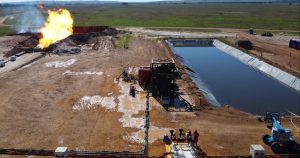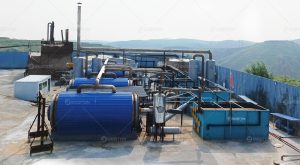The oil and gas industry, while essential for powering our modern world, has long grappled with environmental challenges, one of which is the generation of oil sludge during the extraction and refining processes. Oil sludge, a mixture of oil, water, and solid particles, poses a significant environmental hazard. However, a revolutionary technology has emerged as a game-changer in addressing this issue – thermal desorption. This comprehensive exploration aims to shed light on the thermal desorption equipment revolution and its role in providing eco-friendly solutions for oil sludge management.

Understanding Oil Sludge: A Persistent Challenge
Oil sludge, also known as tank bottoms, is a byproduct of the oil and gas industry, formed during the extraction, transportation, and refining of crude oil. It consists of a complex mixture of hydrocarbons, water, heavy metals, and solid particles. The environmental impact of oil sludge is substantial, posing risks to soil, water, and air quality.
Conventional oil sludge management methods, such as land disposal or incineration, come with their own set of environmental drawbacks. Land disposal can lead to soil contamination and groundwater pollution, while incineration releases harmful pollutants into the atmosphere. These practices not only contribute to environmental degradation but also hinder the industry’s progress towards sustainability.
Enter Thermal Desorption: A Green Approach
Thermal desorption is a sophisticated remediation technology that utilizes heat to separate and recover hydrocarbons from oil-contaminated materials. Unlike traditional methods, thermal desorption offers an eco-friendly oil sludge pyrolysis equipment solution by minimizing waste, reducing environmental impact, and providing a pathway for the recovery of valuable resources.
The Thermal Desorption Process
The thermal desorption process involves three key steps:
a. Heating: The oil sludge is subjected to elevated temperatures, typically ranging from 200 to 600 degrees Celsius, in the absence of oxygen. This controlled heating causes the hydrocarbons within the sludge to vaporize.
b. Separation: The vaporized hydrocarbons are then separated from the solid components of the sludge. This phase separation allows for the recovery of the hydrocarbons in a purified form.
c. Condensation: The vaporized hydrocarbons are condensed back into a liquid state, resulting in a clean oil product that can be reused or further processed. The solid residues, now free of hydrocarbons, are environmentally benign and can be safely disposed of or repurposed.

Eco-Friendly Advantages of Thermal Desorption
Thermal desorption stands out as an eco-friendly oil sludge solution for several reasons:
a. Minimized Environmental Footprint: Unlike traditional disposal methods, thermal desorption minimizes the environmental footprint associated with oil sludge management. By avoiding land disposal and incineration, this technology prevents soil and air pollution, contributing to overall environmental conservation.
b. Resource Recovery: Thermal desorption allows for the recovery of valuable hydrocarbons from oil sludge. The purified oil product can be reintroduced into the production cycle, reducing the industry’s reliance on new resources and promoting a circular economy.
c. Reduced Greenhouse Gas Emissions: The controlled conditions of thermal desorption result in lower greenhouse gas emissions compared to open-air burning or incineration. This aspect aligns with global efforts to mitigate climate change by reducing carbon emissions associated with waste management practices.
d. Soil Remediation: The pyrolysis project not only extracts valuable hydrocarbons but also remediates contaminated soil. By breaking down and removing the pollutants from the soil matrix, thermal desorption contributes to the restoration of affected ecosystems.
Thermal Desorption in Action: Case Studies
North Sea Oil Industry – Offshore Remediation
In the North Sea, offshore oil platforms faced challenges associated with the disposal of oily waste generated during drilling operations. Thermal desorption emerged as a viable solution, allowing for on-site treatment of oil-contaminated materials. The recovered oil could then be reused within the platform, reducing the need for external sourcing and minimizing the environmental impact of waste disposal in the ecologically sensitive North Sea region.
United States – Brownfield Redevelopment
In the United States, brownfield sites with a history of oil and gas activities often require remediation before redevelopment. Thermal desorption has been successfully employed to treat oil-contaminated soil, facilitating the transformation of once-polluted areas into viable spaces for new infrastructure or community use. This application showcases the versatility of thermal desorption in addressing historical environmental legacies.
Challenges and Considerations
While thermal desorption offers significant advantages in eco-friendly oil sludge management, it is crucial to acknowledge and address challenges associated with its implementation.
Energy Input and Cost: The energy-intensive nature of thermal desorption, particularly in terms of heating the oil sludge, can contribute to high operational costs. Innovations and advancements in technology are needed to optimize energy efficiency and make thermal desorption economically competitive.
Site-specific Considerations: The success of thermal desorption projects depends on various site-specific factors, including the composition of the oil sludge, the scale of contamination, and local environmental regulations. Tailoring thermal desorption processes to specific site conditions is essential for maximizing effectiveness.
Public Perception and Regulatory Compliance: Public perception and regulatory compliance play a crucial role in the acceptance and implementation of thermal desorption projects. Open communication, transparency, and adherence to environmental regulations are vital to gaining public trust and regulatory approval.
Future Directions and Innovations
The future of thermal desorption in oil sludge management holds exciting prospects, with ongoing research and innovation focusing on overcoming existing challenges and expanding its applicability.
Technological Advancements: Ongoing research aims to enhance the efficiency and cost-effectiveness of thermal desorption technologies. Advanced heating methods, improved process control, and the integration of smart technologies are areas of exploration to optimize performance.
Hybrid Approaches: Combining thermal desorption with other remediation technologies or treatment methods, such as bioremediation or chemical oxidation, may offer synergistic benefits. Hybrid approaches have the potential to address a broader range of contaminants and provide more comprehensive solutions.
Small-scale and Mobile Units: The development of smaller, mobile thermal desorption units can offer flexibility in addressing localized contamination or providing on-site remediation in remote areas. These units can be particularly beneficial for oil and gas exploration activities in challenging environments.
Waste-to-Energy Integration: Exploring ways to integrate thermal desorption with waste-to-energy technologies can further enhance the sustainability of oil sludge management. By harnessing the heat generated during the process for energy production, thermal desorption can contribute to a more circular and energy-efficient system.
Conclusion
The thermal desorption revolution represents a turning point in the quest for eco-friendly solutions to address the persistent challenge of oil sludge in the oil and gas industry. By harnessing the power of heat to separate and recover valuable hydrocarbons, thermal desorption not only mitigates environmental risks but also contributes to resource recovery and sustainable practices.
As the industry continues to evolve in response to global environmental concerns, the role of thermal desorption is set to expand. Ongoing research, technological advancements, and collaborative efforts among industry stakeholders, governments, and environmental organizations are essential for unlocking the full potential of thermal desorption in oil sludge management.
Eco-friendly oil sludge solutions are not just a necessity for regulatory compliance; they represent a commitment to responsible environmental stewardship and the long-term sustainability of the oil and gas industry. The thermal desorption revolution exemplifies how innovation can lead to a harmonious coexistence between industrial progress and ecological well-being. As we move forward, embracing and refining technologies like thermal desorption will be pivotal in shaping a future where oil and gas operations not only meet energy demands but do so with the utmost respect for our planet.